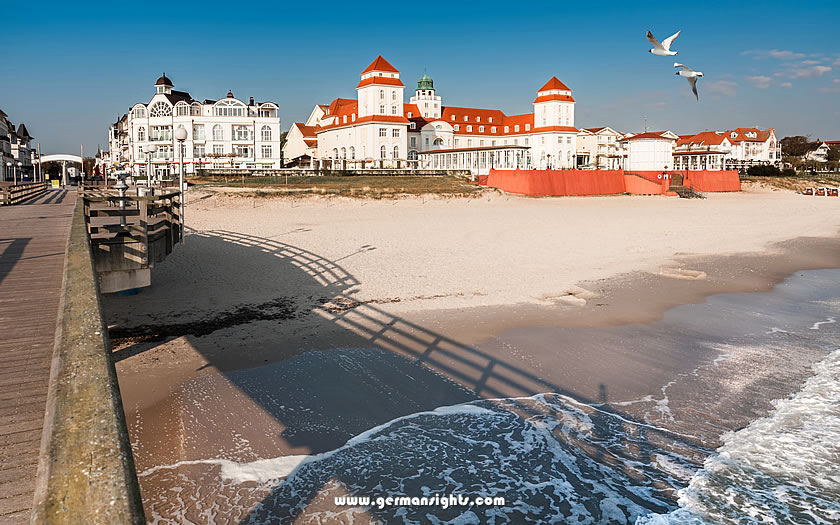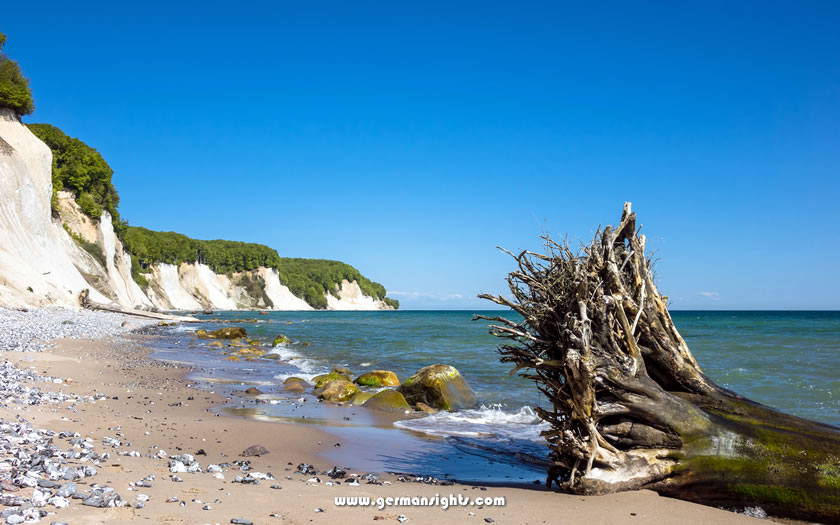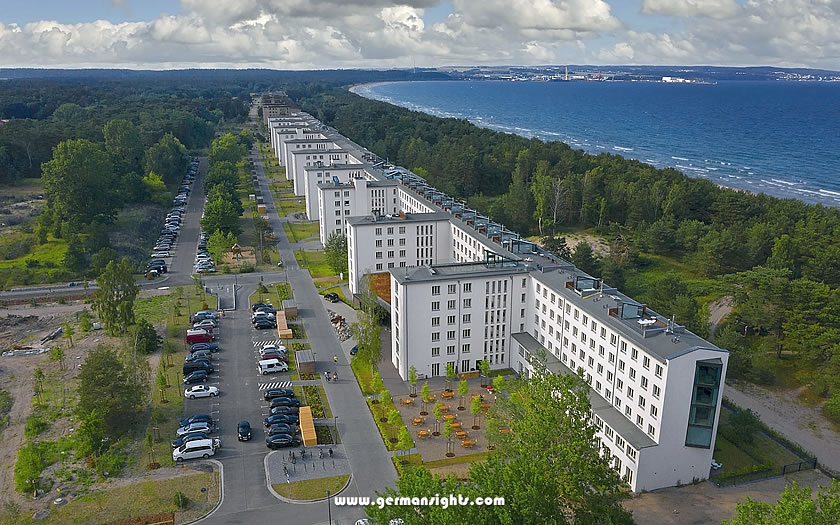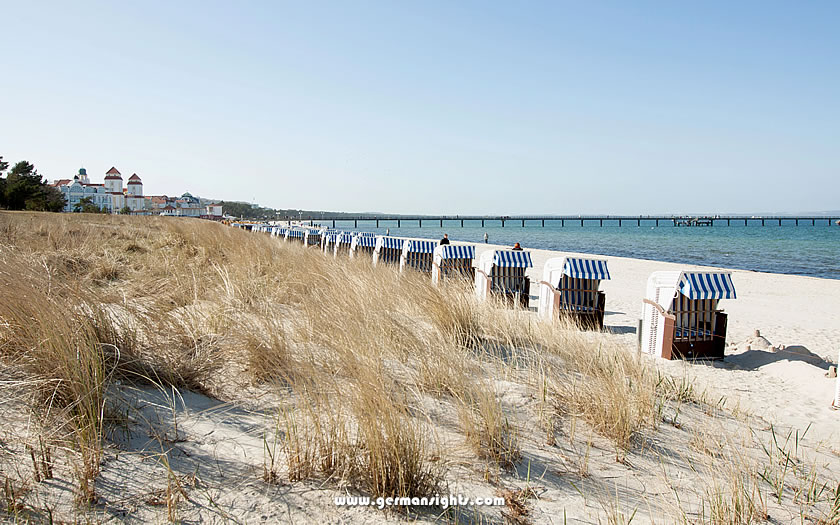Binz is Rügen's crown jewel, combining classic Baltic resort architecture with modern beach tourism. The town's distinctive white villas line the promenade, their restored facades a testament to Germany's earliest seaside holiday traditions.
Binz, unlike busier coastal destinations, retains an air of sophisticated leisure that dates back to its origins as a fashionable 19th-century resort.

View of the beach resort of Binz on Rügen
The heart of Binz is its five-kilometre sandy beach, the longest on the island of Rügen. The beach's gradual descent into the Baltic Sea creates ideal swimming conditions for families, while the spotless white sand invites long walks and relaxation in the distinctive wicker beach chairs known as Strandkörbe. A German beach tradition since 1882, these wicker beach chairs protect visitors from the sun and wind while offering a prime view of the bay.
Away from the beach, Binz offers a careful balance of activity and tranquility. The town's pier stretches 370 metres out into the Baltic Sea and is both a popular fishing spot and a stunning sunrise viewing platform.
The surrounding Granitz forest adds a natural drama to the seaside setting, with footpaths linking the town to hidden coves and dramatic chalk cliffs.
Binz is located on the east coast of Rügen, Germany's largest island, on the shores of the Baltic Sea in the state of Mecklenburg-Western Pomerania.
The town is located in a sheltered bay between the Prorer Wiek and Granitz forests, approximately 240 kilometres north of Berlin. This strategic location provides shelter from strong winds and direct access to some of the Baltic's finest beaches.
The surrounding geography plays a crucial role in Binz's appeal. To the north lies the famous Jasmund National Park, home to the iconic chalk cliffs of the Königsstuhl. The area's UNESCO World Heritage beech forests provide a striking contrast to the coastal landscape.

White cliffs on Rügen island
To the south, the historic hunting lodge of Granitz Castle sits on a wooded hill with panoramic views of the island and sea.
Binz is connected to several important destinations in the immediate vicinity. The seaside resort of Sellin is just 4 kilometres to the south, while the former fishing village of Sassnitz is 10 kilometres to the north.
The island's capital, Bergen auf Rügen, lies 13 kilometres to the west and serves as the main transport hub for the region. This central location makes Binz an ideal base from which to explore Rügen's many attractions.
The town itself spreads inland from the seafront in a planned layout typical of 19th century resort development.
The main shopping street, Hauptstraße, runs parallel to the beach promenade, creating a compact, walkable town centre. Behind this, residential areas blend into the surrounding woodland, maintaining the transition between urban and natural spaces that characterises Binz's appeal.
If you know when you are planning to go but haven't decided on accommodation, then use the map below to get an idea of which properties are available and to compare prices during the period you wish to travel.
Enter your proposed dates and use the '+' to zoom in on a location and reveal more properties. Click on the price above a property to see more information.
(Please note that this selection will also include some guesthouses, pensions and self-catering apartments for those who are interested in that form of accommodation!)
Alternatively, if you would like a list of properties available on your proposed dates of travel, use the search box below to find accommodation:
The transformation of Binz from a small fishing village to an elegant seaside resort reflects the broader history of European beach tourism.
The village first appeared in historical records in 1318 as a modest settlement of just four fishing families. For centuries it remained a quiet community focused on fishing and farming, with little sign of a future as a prestigious resort.
The town's fortunes changed dramatically in the 1860s when Germany's emerging middle class discovered the therapeutic benefits of sea bathing.
The first official seaside visitors arrived in Binz in 1866, staying with local families as the concept of organised tourism was still in its infancy. The construction of the first purpose-built bathhouse in 1876 was the start of Binz's deliberate development as a seaside resort.
The arrival of the railway in 1884 transformed Binz, connecting it to the larger cities and sparking a building boom. Local entrepreneurs and wealthy investors built the distinctive white villa architecture that now defines the character of the town.

Classic German beach resort architecture in Binz
Known as Bäderarchitektur, these buildings featured elaborate wooden verandas, towers and decorative elements that combined classical aesthetics with seaside functionality.
The Second World War brought great changes to Binz. The Nazi regime's massive Prora complex, designed as a seaside resort for 20,000 workers, was built nearby but never fulfilled its intended purpose.

The Prora resort complex on Rügen
After the war, under East German rule, Binz became a popular holiday destination for trade unions, with many historic villas serving as collective holiday homes.
The reunification of Germany in 1990 opened a new chapter in the history of Binz.
Many historic buildings, neglected during the communist era, were carefully restored. The town regained its status as a premium resort, this time balancing its historic character with modern amenities.
The beach promenade is the heart of Binz's attractions. The restored pier, which stretches 370 metres out into the Baltic Sea, offers a superb view of the sunset and has a popular restaurant at its end.

Beach chairs and sand dunes in Binz
The Kurhaus Binz anchors the cultural life of the town with its Art Nouveau elegance. Nearby, Villa Salve is the finest example of restored spa architecture, with its ornate wooden balconies. Villa Schalfkorn is now a fascinating museum, with exhibits that transport visitors back to resort life in the 1900s.
Nature surrounds the town on all sides. The Granitz Forest offers a network of marked trails leading to the impressive Granitz Hunting Lodge. The tranquil Schmachter See offers excellent birdwatching and quiet walks away from the hustle and bustle of the beach.
There are six different beach sections along the coast, each with its own character, from lively family areas to quiet nature zones.
Binz has a number of locations which provide information for visitors to the town. The Haus des Gastes is open seven days a week all year round and is located opposite the Kurpark. The visitor information office at the Seebrücke is also open seven days a week, but only in the summer months.
More information is available at Binz station which serves the 'Rasender Roland' steam rail service. Here there is a library and small local history museum open six days a week in summer and on weekdays in the winter months.
Website: binzer-bucht.de